Robert Bancks (Banks), 1765 - 1841
also as Bancks and Son, with
Robert Bancks Jr., 1799 - 1830
by Brian Stevenson
last updated July, 2023
Robert Bancks (also written "Banks") was a well-regarded manufacturer of microscopes and other optical and scientific instruments (Figures 1-10). He was designated Mathematical, Optical, and Philosophical Instrument Maker to George, the son of King George III, who was Prince of Wales (until 1811), Prince Regent (1811-1820), then King George IV (1820-1830), and also his successor, King William IV. Among Bancks other renowned customers were Charles Darwin (who took a Bancks microscope on his Beagle trip) and Robert Brown (who described “Brownian” motion).
Robert Bancks is reported to have begun his shop at 440 Strand, London, in about 1795. There, he briefly partnered with his brother, Anthony Olddiss Bancks (1767-1849). The brothers separated within a few years. The address of Robert Bancks' shop changed to 441 Strand in 1805, likely due to street renumbering. His eldest son, also named Robert, joined as a partner during the mid- to late-1820s, forming Bancks and Son. In 1829, they moved to 119 New Bond Street. The son died there in November, 1830. The elder Bancks continued at that location, retaining the name of Bancks and Son. He evidently retired in 1834-35, and moved to a house in Knightsbridge.
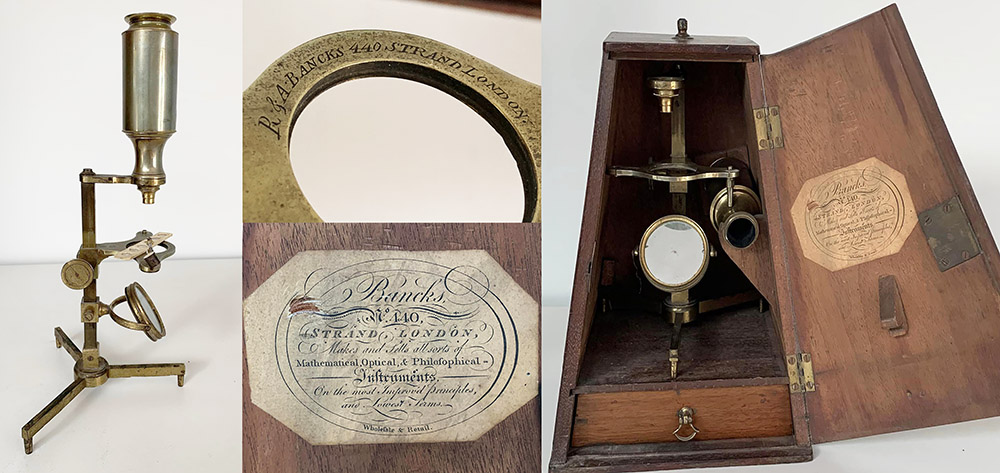
Figure 1.
An unusual microscope that is signed "R. & A. Bancks", dating it to around 1795 - 1797. The pyramidal case has a trade label for "Bancks", with address 440 Strand. The number of Robert Bancks' shop changed from 440 to 441 in 1805. The tripod-mounted instrument can be used as either a compound or simple microscope. Adapted by permission from histoiredumicroscope.com.

Figure 2.
Bancks produced these small, case-mounted simple microscopes for several decades. An 1805 issue of “Englische Miscellen” stated that “der mathematische Instrumentenmacher Bancks Nro. 440 Strand” makes “pocket microscopes in a box no more than three inches long, seven and a half inches wide, and half an inch thick” (paraphrased). The instrument on the left is engraved “Banks, London Mathl Ins Makr to the Prince of Wales” (the future King George IV was Prince of Wales until 1811), and the center/right instrument is engraved “Banks invt 441 Strand” (he declared to be inventor of this type, and operated from 441 Strand from 1805 until ca. 1829). Rack-and-pinion adjusts the height of the stage for focusing. Three simple lenses can screw together, for use alone or in combination, giving 6 different magnifications. Despite the fine finish of the microscopes and the outside of their cases (often featuring contrasting wood inlays on the edges), the case interiors are not divided, so items freely shift during travel.

Figure 3A.
A pamphlet that accompanied a small Bancks’ case-mounted microscope. It is addressed 440 Strand, Bancks’ address from ca. 1795 until 1805. Adapted for nonprofit, educational purposes from an internet auction site.
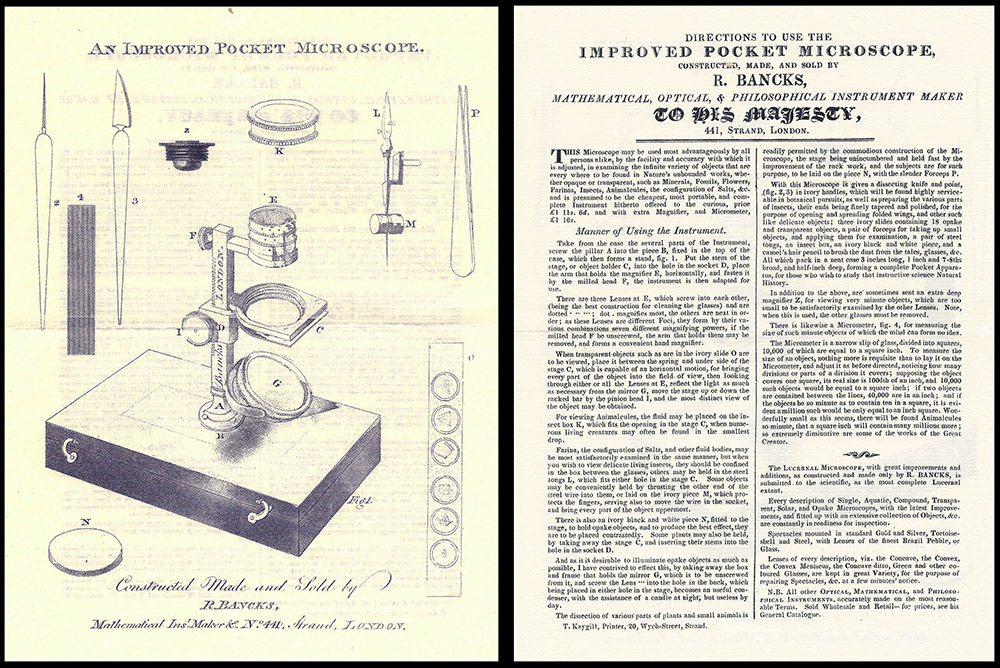
Figure 3B.
This version of the pamphlet is addressed 441 Strand, and described Bancks as “Mathematical, optical, and Philosophical Instrument Maker to His Majesty” (i.e. King George IV, who ascended to the throne in 1820. Bancks received a royal appointment on April 5 of that year). Adapted for nonprofit, educational purposes from an internet auction site.
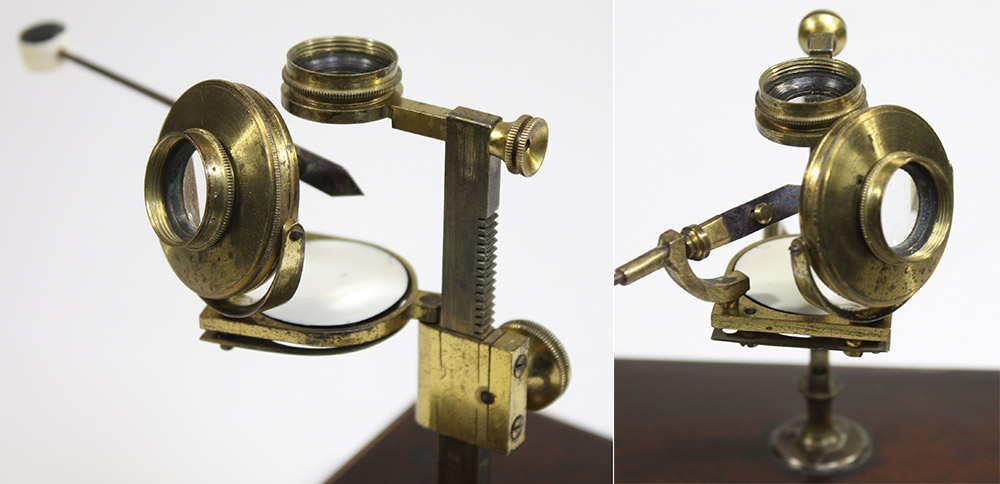
Figure 4.
A number of Bancks’ microscopes had a mirror that can also be used as a stage-mounted condenser. The mirror unscrews from its housing, and one of the simple lenses can be screwed into a hole in the mounting.
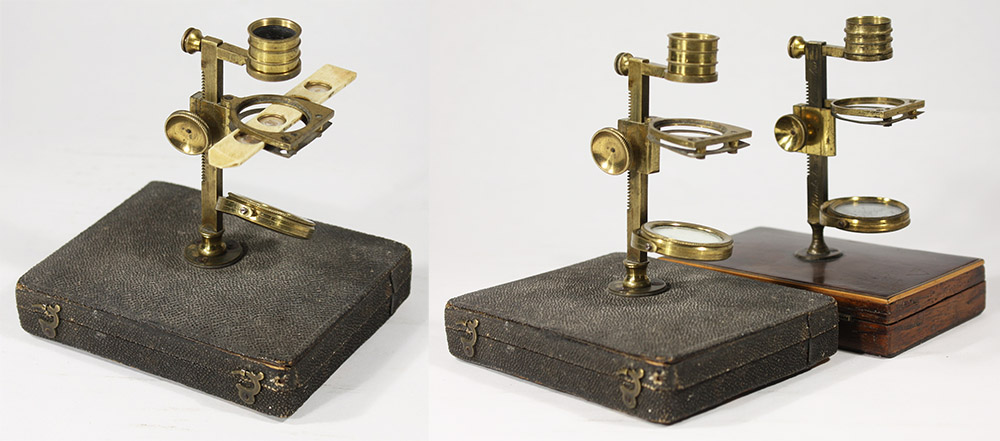
Figure 5.
An unsigned simple microscope that is almost identical to Bancks’ signed pocket microscopes, mounted on a sharkskin-covered case. There is a strong possibility that this microsocpe was made by Bancks during his early days as a manufacturer. Note that Bancks called his wooden-cased microscopes "improved" (Figures 2 and 3).

Figure 6.
A variant of Bancks’ pocket microscope, possessing a compound body tube and larger cabinet. Note that the mechanisms are essentially the same as on his smaller, simple microscopes, including the combination mirror/condenser (Figures 1-4). It is engraved “Bancks London invt ”. Adapted for nonprofit, educational purposes from an internet auction site.
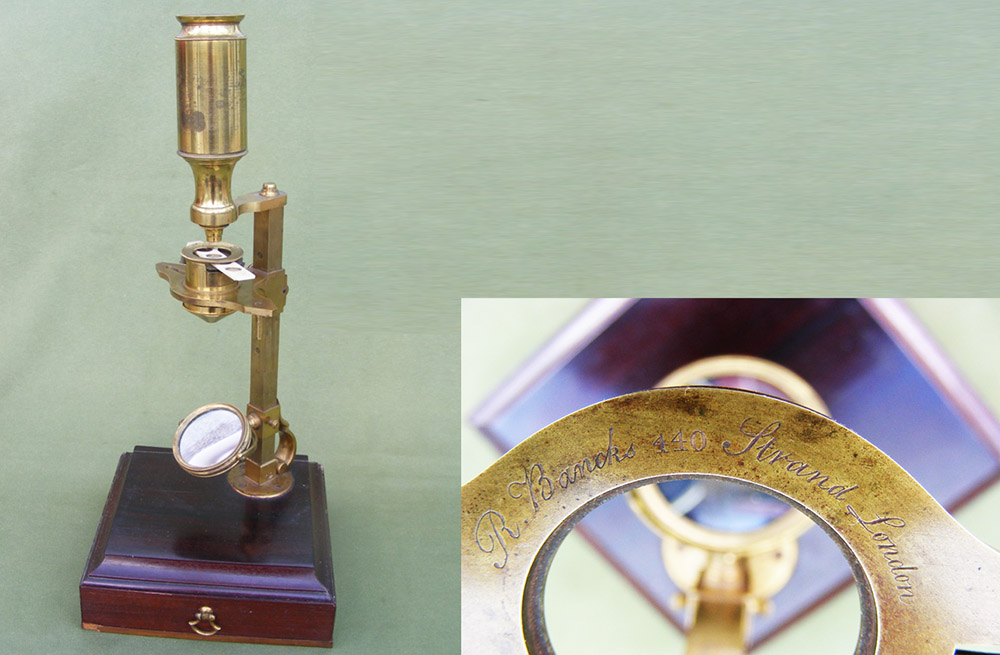
Figure 7A.
An "Adams Universal" / "Jones Improved"-type microscope, signed on the stage with "R. Bancks, 440 Strand, London". That address dates it to between ca. 1795 and 1805. Adapted for nonprofit, educational purposes from an internet retail site.
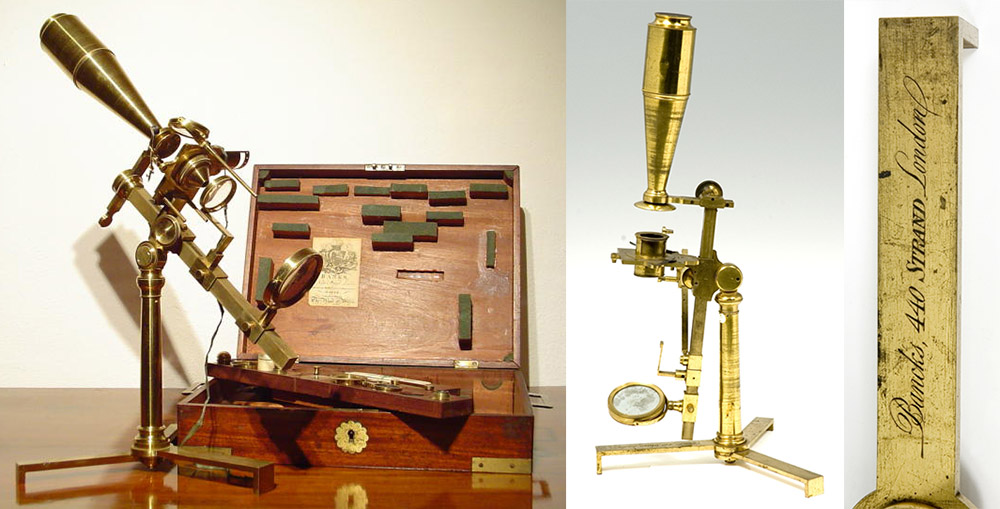
Figure 7B.
Two “Jones Most Improved”-type microscopes, both signed on the foot with “Bancks, 440 Strand, London”, dating them to between ca. 1795 and 1805. Adapted for nonprofit, educational purposes from (left) http://www.bononiaemicroscope.com/en/the-microscopes/england/42-banks-jones-most-improved-type.html, and (right) http://www.mhs.ox.ac.uk/collections/imu-search-page/record-details/?thumbnails=on&irn=6842&TitInventoryNo=47676.
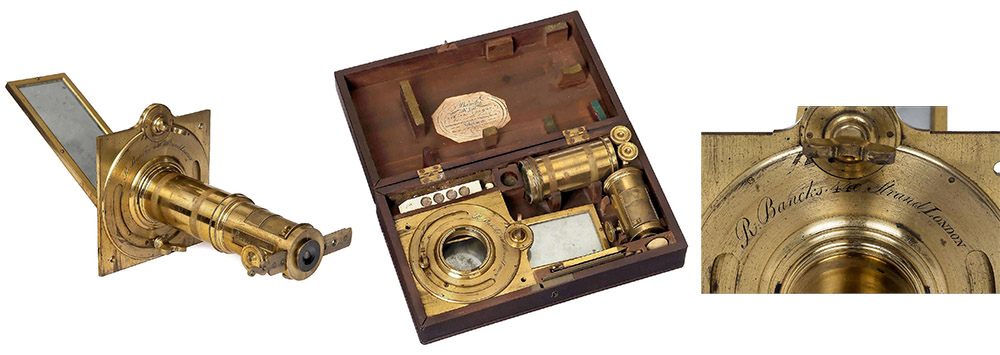
Figure 8.
A solar microscope, engraved “R. Bancks, 440 Strand, London”, dating it’s production to between ca. 1795 and 1805. Adapted for nonprofit, educational purposes from an internet auction site.
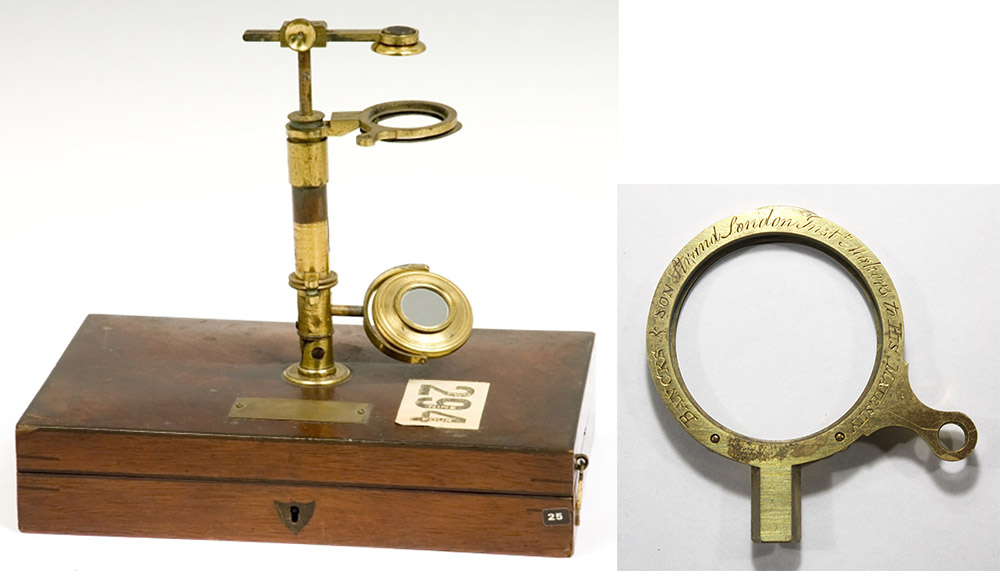
Figure 9.
A larger case-mounted microscope, with “Bancks & Son Strand London Inst Makers to His Majesty" engraved on the stage. That refers to George IV, who became King in 1820. The Bancks moved from their Strand shop in 1829.

Figure 10.
A large case-mounted microscope, engraved “Bancks & Son Strand London Inst Makers to His Majesty" on the stage, dating it to between 1820 and 1829. The lenses include Wollaston doublets and a triplet. Adapted for nonprofit, educational purposes.
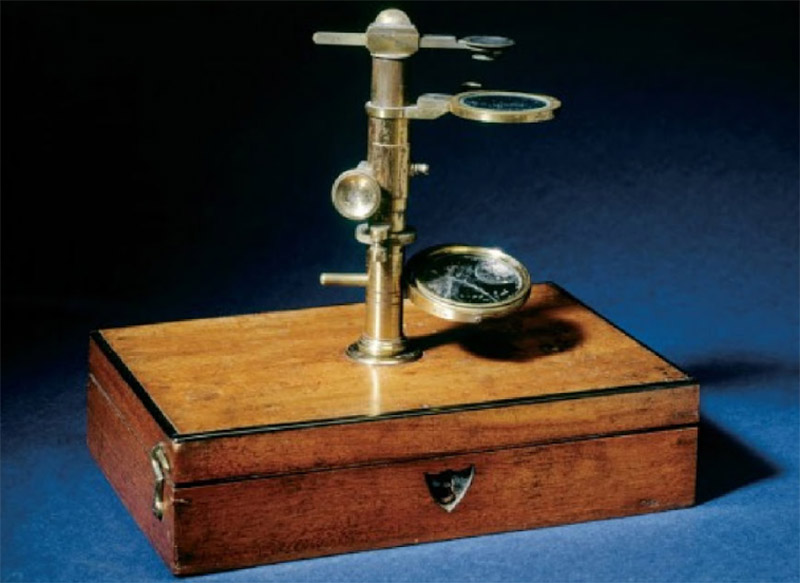
Figure 11.
This microscope was carried by Charles Darwin on The HMS Beagle (1831-1836). The stage is signed “Bancks & Son, 119 New Bond Street”, the business address from 1829 until ca. 1834. Adapted for nonprofit, educational purposes.
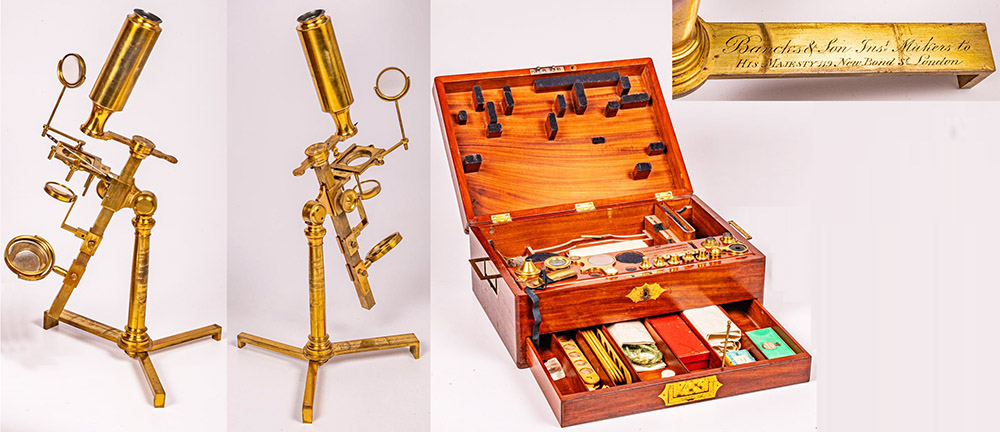
Figure 12.
A "Jones' Most Improved"-type microscope signed “Bancks & Son, 119 New Bond Street”. This was their address from 1829 until ca. 1834. Robert Bancks' son died in 1830. Adapted for nonprofit, educational purposes.
All identified legal records use the spelling “Bancks” for the surname of our microscope-maker and his family. For unknown reasons, engravings and labels on his products variously spell it “Bancks” or “Banks”. We will use Bancks throughout this essay, except where quoting the other spelling.
Records of the London Guild of Joiners (they were originally a guild of fine carpenters, but many were manufacturers of scientific apparatus) indicate that our Robert Bancks was granted Freedom of the City of London in 1803, by virtue of his father having been a Joiner. That man, also named Robert, had apprenticed with William Murry/Moury in 1755. He became a member of the Joiners’ Guild in 1765. In January of that year, he married Ann Olddiss, and they gave birth to our future microscope-maker on November 18, 1765 (Figure 13). A second son, named after Ann’s father, Anthony, was born in 1767.
Our microscope-maker was very likely the Robert Bancks who apprenticed with “mathematical instrument maker” John Dalton in 1779 (Figure 14). Bancks would then have been 13 1/2 years old, an appropriate age to begin one’s apprenticeship. A standard apprenticeship lasted for seven years, so Bancks would likely have been released in 1786. His whereabouts until the mid-1790s are not known. His name does not appear in business directories, so it can be assumed that he worked as a journeyman for Dalton or another instrument-maker.
Robert’s younger brother, Anthony Olddiss Bancks, began his apprenticeship in 1781. He worked with John Kitchingman, also a member of the Joiners’ Guild. He became a member of the Joiners in 1792. Gloria Clifton reports that Anthony was working as an “optician” at 25 Piccadilly by 1794. That building was also the address of Edward Hall’s playing card and printing company. Anthony married Mary Ann Hall in 1790, probably a daughter of Edward. Anthony Bancks eventually became a partner, then owner, of the card-making business (Figure 17).
Clifton indicates that our Robert Bancks was also associated with 25 Piccadilly, but the connection is unclear.
It is certain that Robert Bancks opened an independent shop at 440 Strand circa 1795. A city directory from 1797 listed him as an “optician” at that address. His brother, Anthony, was not listed, suggesting that he had left the Bancks' brothers partnership by that time.
Robert married Martha Spence on June 17, 1798. Their first son, Robert, was born on July 7, 1799. Parish baptism records and government censuses indicate that they had at least seven additional children: 2 boys and 5 girls. Both of those boys appear to have died when very young, and two of the daughters died while in their twenties.
As noted above, Robert became a member of the Joiners’ Guild in 1803. Guild membership was required to become a master, and Robert took his first known apprentice in December, 1803, George B. Sampson.
As might be expected for a successful business, Bancks had employees in addition to his apprentices. One is known, Edward Maxwell, “a journeyman to Mr. Banks”, who testified in an 1812 trial of a robbery at Bancks’ shop.
Along with his microscopes, telescopes, and drafting tools, Bancks produced a variety of less familiar apparatus. An 1812 paper that dealt with “experiments on the soniferous vibrations of the gasses” stated that anyone who desired to own a copy of the experimenters’ device (a complex chamber attached to an organ pipe) “may procure it of Mr. Bancks, 441, Strand”. An 1813 letter on “producing instantaneous light” described an “apparatus for producing a light … sold by Banks, 441, Strand. It consists of a handsome box, lined with copper, containing hydrogen gas, confined by water. On turning a cock, a stream of the gas issues from it, and is inflamed at the same moment by an electrical spark proceeding from an electrophoros placed at the bottom of the box: a candle or lamp is placed before the flame, by which it is immediately lighted. The cock must then be turned back to prevent an unnecessary consumption of the gas. The process for replenishing the box with the gas is cheap and easy, and is but seldom required. This apparatus would save the expense of a constant light in a bedchamber, and might be used with perfect safety”. In 1816, Bancks sold a booklet, Description and Directions for the Use of Bancks's Improved Plate Electrical Machine: Manufactured and Sold by Him Only, Wholesale and Retail, No. 441, Strand, London. An 1831 report of an attempted theft in the London Morning Post indicated that Bancks sold writing pens “A fashionably-attired young man was charged at this Office on Saturday with endeavouring to pass a gilt sixpence for half a Sovereign at the house of Mr. Bancks, optician, in New Bond-street, in payment for three steel pens”. The National Museum of Science and Industry (UK) holds several examples of Bancks’ apparatus, including a hydrometer, a theodolite, and an electrostatic machine.
Bancks and his eldest son formed a partnership during the 1820s. Having been born in 1799, the younger Robert Bancks would likely have begun his apprenticeship in 1813, and been freed around 1820. Several large case-mounted microscopes are known that were signed “Bancks and Son”, with the address of 441 Strand. They also state Instrument Maker to His Majesty, and therefore date from after King George IV’s 1820 ascension.
City directories and tax records indicate that the Bancks moved their home and business during 1829 to 119 New Bond Street.
The son died on November 5, 1830. The elder Bancks evidently continued to use the business name of Bancks and Son, as all known instruments from 119 New Bond Street bear that name.
The New Bond shop was closed in 1834 or 1835. The 1834 City of London Electoral Register shows Robert Bancks at Bond Street, while the 1835 Register places him at Brompton Row, Knightsbridge. Bancks evidently retired there, as no instruments are known to bear that address. It seems to have been a moderately large home, to judge from the 1841 census: in addition to Robert and Martha, there were three unmarried daughters, three 8-10 year old girls who were students of daughter Mary, and a female domestic servant.
Robert Bancks died on August 21, 1841.

Figure 13.
Top: Parish record of the marriage of our microscopist’s parents. Middle: Parish baptism record of Robert Bancks, noting that he was born on November 18, 1765, and his family lived on Petticoat Lane. Bottom: Parish baptism record of younger brother Arthur Olddiss Banks, noting the same address.

Figure 14.
May 19, 1779 record of apprentice duties paid by “John Dalton of St Sepulchre London Mathematical Instrument Maker” for Robert Bancks.
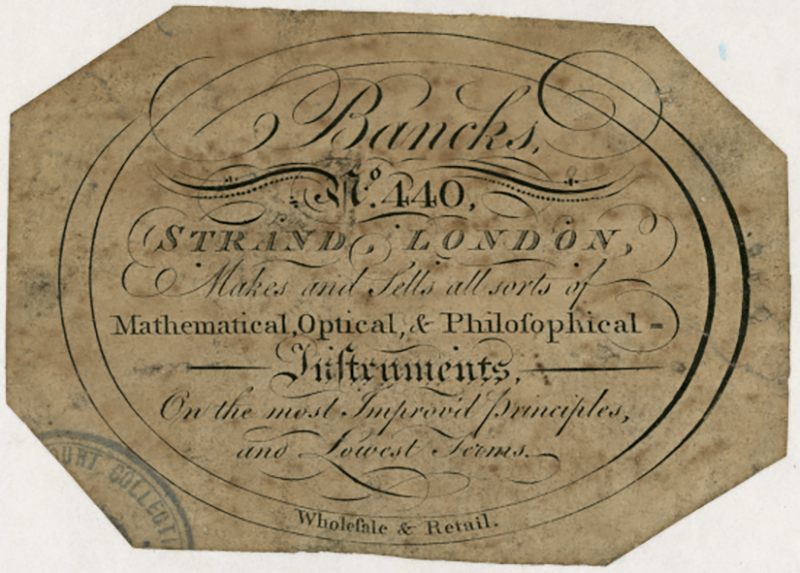
Figure 15.
Robert Bancks’ trade label with the address 440 Strand, from between ca. 1795 and 1805. Adapted for nonprofit, educational purposes from http://collectionsonline.nmsi.ac.uk/detail.php?type=related&kv=8002159&t=objects.

Figure 16.
Telescope signed “Bancks & Son, 441 Strand, London”, dating it from the mid- to late-1820s. Adapted for nonprofit, educational purposes from http://www.arsmachina.com/t-bancks5046.htm
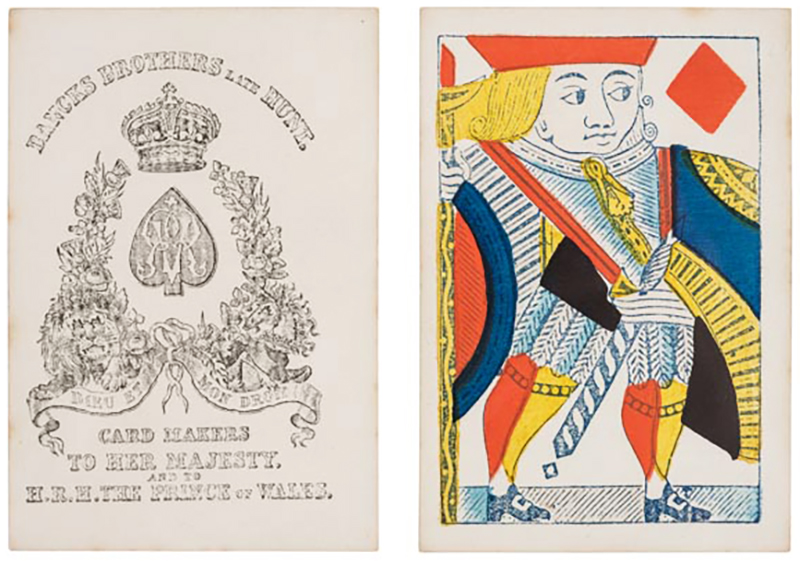
Figure 17.
ca. 1860 playing card that was produced by Robert Bancks’ nephews, sons of Arthur Olddiss Bancks.
Acknowledgements
Thank you to Joe Zeligs for numerous fruitful discussions of historical microscopists, and to the owner of https://histoiredumicroscope.com for generously giving permission to share pictures of their Bancks microscope.
Resources
Apprenticeship dues paid for Robert Bancks, son of Robert Bancks of Spittlefields (deceased), to William Moury, Joiner (1755) accessed through ancestry.com (note: it was tradition among many families to name children after their parents or grandparents. Thus, our microscope-maker’s father and grandfather were both named Robert, as was also his first son)
Apprenticeship dues paid for Robert Bancks, to John Dalton (1779) accessed through ancestry.com
Apprenticeship dues paid for Arthur Olddiss Bancks, to John Kitchingman (1781) accessed through ancestry.com
Apprenticeship dues paid for George B. Sampson, to Robert Bancks (1803) accessed through ancestry.com
Bancks, Robert (1816) Description and Directions for the Use of Bancks's Improved Plate Electrical Machine: Manufactured and Sold by Him Only, Wholesale and Retail, No. 441, Strand, London
Bannerman, W. Bruce (1904) Monumental inscriptions from the burial-ground of St. George, Hanover Square, London: “Mr. Robert Bancks, Junr, of New Bond Street, died Nov. 5, 1830, aged 31. Martha Bancks, sister of the above, died May 11, 1833, aged 26. Ann Bancks, sister of the above, died April 9, 1835, aged 29. Mr. Robert Bancks, father of the above, died Aug. 21, 1841, aged 76. Martha, wife of Mr. Robert Bancks, died Nov. 20, 1841, aged 74”, Miscellanea Genealogica Et Heraldica and the British Archivist, Vol. 5, 3rd series, Mitchell Hughes and Clarke, London, page 167
Baptism record of Robert Bancks (1765) Parish records of St. Mary, Whitechapel, accessed through ancestry.com
Baptism record of Anthony Olddiss Bancks (1767) Parish records of St. Mary, Whitechapel, accessed through ancestry.com
Baptism record of Robert Bancks (1799) Parish records of St. Martin in the Fields, accessed through ancestry.com
Baptism record of John Bancks (1804) Parish records of St. Martin in the Fields, accessed through ancestry.com
Baptism record of Joseph Bancks (1809) Parish records of St. Martin in the Fields, accessed through ancestry.com
Burial record of Joseph Bancks (1810) Parish records of St. Martin in the Fields, accessed through ancestry.com
Baptism record of Mary Bancks (1815) Parish records of St. Martin in the Fields, accessed through ancestry.com
Baptism record of Sarah Bancks (1815) Parish records of St. Martin in the Fields, accessed through ancestry.com
Baptism record of Jane Sophia Bancks (1815) Parish records of St. Martin in the Fields, accessed through ancestry.com
City of London Electoral Registers (1834) “Bancks, Robert, Bond Street”, accessed through ancestry.com
City of London Electoral Registers (1835) “Bancks, Robert, Brompton row, Knightsbridge”, accessed through ancestry.com
Clifton, Gloria (1995) Directory of British Scientific Instrument Makers 1550-1851, Zwemmer, London
Crawforth, M.A. (2006) Instrument makers in the London guilds, Annals of Science, Vol. 44, pages 319-377
“E.M.” (1813) Letter on instantaneous light, The Gentleman's Magazine, Vol. 113, page 408
England census and other records, accessed through ancestry.com
Englische Miscellen (1805) Vol. 18, page 8
Freedom of the City of London papers of Robert Bancks (1765)
Ford, Brian J. (2009) Charles Darwin and Robert Brown - their microscopes and the microscopic image, infocus, pages 18-28
The Gardener’s Magazine (1828) “W. S. writes, ‘I should be glad to be informed, through the medium of the Gardener's Magazine, the price and description of a botanical microscope sufficiently strong to examine the grasses, for I have always found them very difficult to examine by a small magnifying-glass; and I believe that there are a great many young gardeners, like myself, who have been prevented from enquiring into that valuable family of plants for want of proper instruments, and likewise deterred from getting them for want of being able to give a proper direction to some of their fellow-servants to get them in London, as they are seldom to be met with in the country’. One of the most complete botanical microscopes is that recommended by Dr. Hooker, of Glasgow, and sold by Jones, 30, Lower Holborn, London, at £3; and with dissecting knives, £5. An improved botanical, or universal pocket microscope, sold by Jones, and by Bancks, 441, Strand, and others, costs £1 8s. A triple botanical magnifier, such as is used by practical botanists about London, and which we should think well adapted for our correspondent, is sold by Bancks for 9s 6d, and a double magnifier for 6s 6d”, Vol. 1, pages 357-358
Goren, Yuval (2014) Darwin’s forgotten microscope from his voyage on HMS Beagle, New York Microscopical Society Newsletter, pages 1-17
Holden´s Triennial Directory (1805) “Bancks Rob., Optician, 441, Strand”
Kent’s Directory of London (1800) “Bancks Robert, Optician, 440, Strand”, page 13
Kerby, Mr., and Mr. Merrick (1812) A continuation of experiments on the soniferous vibrations of the gasses, &c., Journal of Natural Philosophy, Chemistry, and the Arts, page 161
London Morning Post (1831) Report on attempted theft from Robert Bancks, March 28
London Tax Records (1829) Tennant: Robert Bancks, Civil Parish: St George, Hanover Square (this is the location of 119 New Bond Street), accessed through ancestry.com
Lowndes, H. (1797) London Directory, “Bancks Robert, Optician, 440, Strand”, page 19
Marriage record of Robert Bancks and Ann Olddiss (1765) Parish records of St. Mary, Whitechapel, accessed through ancestry.com
Marriage record of Anthony Olddiss Bancks and Mary Ann Hall (1790) Parish records of St. Martin in the Fields, accessed through ancestry.com
Marriage record of Robert Bancks and Martha Spence (1798) Parish records of St. Mary, Newington, accessed through ancestry.com
Newman, C., and M. Jenkins (2017, accessed June, 2018) “There are four key phases that represent the use of 119 New Bond Street during the period of Tallis”, Inside Tallis: Reconstructing the Interiors of Tallis’s London Street Views, https://www.tandfonline.com/doi/full/10.1080/13555502.2017.1336392
Newton's London Journal of Arts and Sciences (1851) Patent: “Robert Olddiss Bancks, of the firm of Bancks Brothers, of Weirhouse Mill, Chesham, in the county of Bucks, and 20, Piccadilly, London, paper-makers and card-makers, for improvements in the manufacture of paper. Sealed 30th November - 6 months for enrolment”, Vol. 28, page 70
Pigot’s Directory (1825) “Banks Robt. 441 Strand”, page 448
Post Office Directory of London (1805) “Bancks Robert, Optician, 440, Strand”, page 16
Post Office Directory of London (1810) “Bancks Robert, Optician, 441, Strand”, page 18
Post Office Directory of London (1817) “Bancks Robert, Optician, 441, Strand”, page 16
Post Office Directory of London (1829) “Bancks Robert, Optician, 441, Strand”, page 21
Robson's London Directory (1842) Card makers: “Hunt, Hall & Bancks, 20 Piccadilly, (to her Majesty)”, page 1318
Taylor, James (2015), The Voyage of the Beagle, Bloomsbury, London
Transcript of the trial of Elizabeth Marrison who “was indicted for feloniously stealing, on the 10th of May, a telescope, value 10 s. the property of Robert Banks, privately in his shop” (1812) https://www.oldbaileyonline.org/browse.jsp?div=t18120513-17
Wakefield's Merchant and Tradesman's General Directory for London (1790) “Edward Hall, Card Maker to Her Majesty, card maker book/paper/printing trades”


















